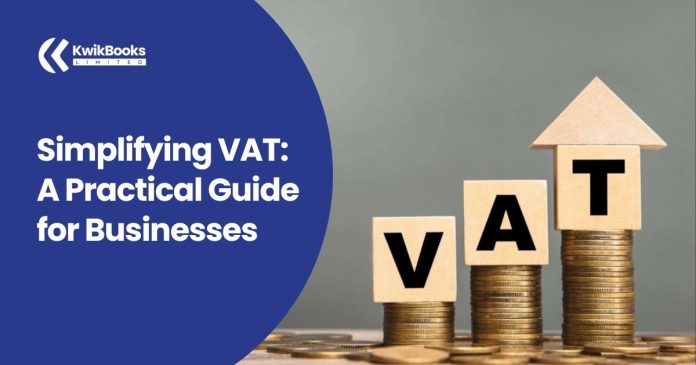You might have run into Business taxes and maybe placed them aside for either a sense of uncertainty or overwhelm. Amongst these, is VAT which is of great significance for businesses to get right! VAT is commonplace, somewhat, in trade and commerce, and yet many entrepreneurs (and more so small business operators), still do not clearly understand VAT; how it works, when it should be applied, and how this should be managed as part of an ongoing business activity. If you get it wrong, VAT will rapidly become an irritant, bothering you, causing deadlines and unnecessary penalties.
The aim of this guide, therefore, is to help you cut through the cobweb. I will help to break VAT down into manageable sections, to understand the significance of VAT, further explore how VAT works in a day-to-day sense and the role technology plays in managing compliance as part of your operational and management responsibility. Whether you are starting up, you have an SME, or if you’re an Executive, you’ll find useful insights here helpful to make VAT more manageable and hopefully less daunting.
What Is VAT and Why Is It Important?
VAT is a consumption tax, on goods and services, taxed at each point in the supply chain, from production to sale! Unlike Income tax which is taxed on profits, VAT will be collected at the point of sale on some percentage of the sale price; and it therefore, will affect both businesses and consumers at the same time!
VAT represents an important source of revenue for governments and a compliance obligation for businesses. If you charge VAT correctly and pay it on time, you will not only be compliant with tax laws, but you will also aid in cash flow management and protecting your reputation.
How VAT Works in Practice
The mechanics of VAT often involve a misunderstanding because it goes through multiple stages:
- Input VAT: This is the tax on goods and services you purchase for your business. For example, if you buy office supplies or machinery, the VAT will be built into the price.
- Output VAT: This is the tax charged on goods and services sold to customers.
- Net VAT Payable: The tax owing to the tax authority is the apportioned difference between output VAT and input VAT.
If your input VAT is larger than your output VAT, you may be eligible for a refund. If it is the opposite, you will owe the tax authority a difference.
VAT Registration: Do I Need It?
Not every business needs to register for VAT. However, once your taxable turnover exceeds a certain amount (exact amount varies by country) registration is required.
Advantages of VAT registration include:
- Establishing legitimacy with clients and suppliers
- The ability to recover input VAT on business-related expenses
- Meeting your legal obligations and avoiding significant fines
However, individuals have the option of registering voluntarily for a smaller business that may enhance credibility and allow you to recover input VAT.
Common Issues Businesses Experience with VAT
VAT sounds simple in theory, but in practice, it comes with many issues:
- Complicated rules: Rates change depending on types of goods, services provided, with exemptions or reduced rates only complicating matters.
- Cash flow challenges: Businesses typically find themselves in a tight cash flow position due to VAT payments if clients don’t pay their invoices on time.
- Calculation errors: Even small errors that appear on invoices or VAT returns will often lead to penalties.
- Regulation change: Different tax authorities update rules on thresholds, reporting, and digital compliance requirements on a regular basis.
Technology and VAT
We live in a digital world, and things operate differently than decades ago. Rather than doing manual calculations or relying on cumbersome spreadsheets, automated software can automate VAT tracking, support accuracy, and free up hours of admin time.
Cloud accounting systems have become very popular. They can combine invoicing, calculations, VAT calculations, VAT, and reporting into a single dashboard to ease compliance burden.
For example, while preparing returns, rather than manually working out numbers, a business can simply use a vat calculator, or a similar tool, and determine the tax component on purchases or sales, instantaneously. These tools are quick, easy to use, and reliable, which will help mitigate the chance of errors.
Online Resources and Tools for VAT Compliance
VAT has been made much easier to manage with the use of the internet. The tax authorities now allow business owners to register for VAT, file VAT and pay VAT returns online.
Furthermore, businesses can tap into digital tools that provide a current view of VAT. An online vat calculator is the most common. They will quickly separate net amounts, gross amounts, and vat amounts, when preparing invoices or returns, this is extremely helpful in saving valuable time. Coupled with accounting software, these digital tools can become part of the business and integrated into a tax strategy.
Best Practices in the Efficient Management of VAT
To ensure you take the right steps for compliance with your VAT responsibilities, it is advised that you follow these good work practices:
1. Maintain Thorough Documentation
Ensure you have stored all invoices, receipts, and any documents used for expenses thoroughly and that any documentation is accessible. Auditors often request prior years’ documentation, and if it is not organised it could be a lengthy recovery process.
2. Reconcile Regularly
Consistently record your reconciliations of bank statements, invoices, and input tax history to help identify discrepancies in a timely manner.
3. Have Knowledge of Any Applicable Rates
It is very useful to know the tax rates and thresholds specific to your industry since the VAT rates are constantly changing. Your knowledge of this in a timely manner is what helps you remain compliant. For example, describing specific foods or digital goods might have a different tax rate under the Goods and Services Tax (GST) or exempt itself from the tax rate.
4. Plan Wisely for Cash Flow
Set aside the future amounts needed to meet your obligations towards VAT so it doesn’t end up creating a cash liquidity problem.
5. Use Automation
It is highly useful to have specialists in both the tax and accounting field available to ensure compliance and refer back to a possible plan for how to achieve VAT compliance.
The Future of VAT and Digital Compliance
It can be understood that governments worldwide are going to a digital first model in the tax system as a whole. From electronic invoicing to digital attachments, everything can point towards compliance and being required.
This evolving environment is a challenge and an opportunity for businesses. It requires businesses to adapt to new systems and processes and keep current with regulatory changes, but it also offers the potential for greater efficiencies, fewer errors and faster recovery time.
Businesses that take the initiative and embrace digital compliance sooner are not just ahead of the penalty curve, but have less hassle with their compliance and may find that they enjoy better visibility of their finances.
Conclusion
VAT compliance does not have to be burdensome. By being aware of the overall picture, using the right tools and implementing your best practices, businesses can make VAT compliance something manageable instead of burdensome. Technology offers businesses the very real potential to automate some calculations, automate record keeping and stay compliant.
For entrepreneurs and small business owners, the expectation is simple: don’t let VAT compliance become another hurdle. By employing the right strategy and digital support, you can maintain operational flow and ensure compliance simultaneously.

